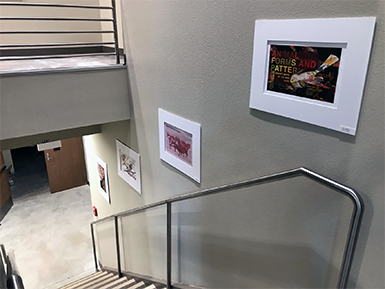•••
Arthur (“Bugs”) Baer, CAMOUFLAGE. Evening World (New York). August 18, 1917, p. 3—
THIS WAR is being fought on words that ain’t in the dictionary. Old man Noah Webster knew a few spoonfuls, but he didn’t know anymore about camouflage than a hog does about Sunday. You can lamp his dictionary until you sprain an eye, but you won’t apprehend anything about camouflage in his unabridged word garage. Camouflage is a bilking industry with the libretto and music written by the French. The theory is to swindle the German’s eyes. The Frenchmen cover ‘emselves with a lot of leaves. They got the theory from Adam and Eve, but ain’t paying royalities.
After he is camouflaged up in a set of form fitting leaves, the Frenchman ankles off for a short vegetarian stroll toward the Kasier’s trenches. Some husky Boche tosses his optic toward him, but figures him out for a rhododendren bush rehearsing for a tableau vivant. First thing he knows, the rhododendron bush goes Democratic and poor old Hans is listed among the slightly killed, totally wounded or partially missing.
THE IDEA of camouflage is to gyp the enemy. Give him one five for two tens. You heard about the cowboy who called on his best girl and found her bivouacking in another cowboy’s lap. He pulled out his .45 calibre revolver to shoot the beauty spot off her false, deceiving chin, when she looks at him like page 254 of Ouida’s novels.
“Do you believe your dearie, or do you believe your eyes?” she piped.
The poor fish believed his dearie, and they got married and lived snappily ever after. She had that fool cowboy all camouflaged up with her metropolitan tongue and city ways.
Still, camouflage is no novelty among the unfair sex. A flapper will high heel along the macadamized turf, all ambushed up in a swarm of Djer Kiss [the flying kisses of fairies]. She will have a gang of summer furs lurking on her shoulders and a mob of paint, powder and other beauty utensils loitering on her face. She will have a complexion fairer than a Supreme Court decision. But when she gets home and starts to uncamouflage, she puts on ten years for everything she takes off. She has one of those removable complexions. By the time that she has moulted her blonde hair, shed her automatic teeth and discarded her mechanical eye, she is older than hieroglyphics, and gains every lap.
She has one of those folding complexions that you can carry in your handbag. The French have no monopoly on that camouflage institution. Yea bo.
UNDER THE modern regime of beauty camouflage, everything about a woman complexion is detachable except her ears.
There are different branches of study in the camouflage curriculum. In Washington, the Senators have oratorical camouflage down to a science. Their speciality is painting word pictures, using their chin as a brush. There isn’t a battle that the Senate can’t win with a few maxillary calisthenics. Rhetorical camouflage is great stuff, but you can’t bridge the ocean with a pontoon of words. Any union Senator with his vocal camouflagers on can build a fleet in three paragraphs or raise an army with a few chin excursions. Aesop’s jackass had the camouflage idea when he attended the zoo bal masque wearing the lion’s coat and vest, but a few chirps of his fool mule tongue gummed his camouflage.
The gent who disguises himself behind a camouflage of women’s skirts in order to escape military service is smaller than the Republican vote in Alabama. A guy that little can ambush himself behind a cancelled postage stamp. The slackers are utilizing a camouflage of women’s skirts, dependent relatives, conscientious objections, flat feet, weak heart and weaker knees. Which is a camouflage that fails to camouflage by quite a few flages. And a culprit who tries to hide behind a woman’s petticoats would have to pass his career in a bureau drawer. That’s where the ladies are wearing their pettiskirts. Nope, we ain’t married, but we read The Delineator [a women’s magazine at the time].
THE PARAMOUNT idea of camouflage is to create an aura of low visibility which will enable you to ramble around in safety. The chameleon has the right idea, and one that might be elaborated. For instance, a bill collector would never find you if you were camouflaged as a waste basket. All the props you need for this ambush is a loose wicker basket and a hat made of old newspapers, vacant letters and unraveled souvenir postcards. You can circumvent the heat by camouflaging yourself as a mint julep. With enough practice you can become a perfect julep. Even your wife will be unable to detect the difference on your breath.
By camouflaging yourself as a porcupine with a flat wheel, you can secure enough elbow space in the subway to draw in a breath edgeways once in a while. Bat as drawing in a subway breath is suicide at a nickel a ticket, this camouflage is rather intricate.
Peace hath her camouflages as well as war. With a lttle cranial dexterity and a few cerebral gymnastics, camouflaging can be utilized to alleviate the inconvenience of civilization.
There will be a camouflage for every ill.
Of course, in the case of the poor henpecked husband, we can paint no disguise with a brush.
The only camouflage will be distance. And you will have to paint that with your heels.
Below (updated 24Mar2019): Moments ago while browsing the "free photo website" of Gratisography, we ran across this photograph by Ryan McGuire which, by fortunate coincidence, uses much the same trickery as the "wedlocked" cartoon from 1918.
 |
| Photo by Ryan McGuire |








































